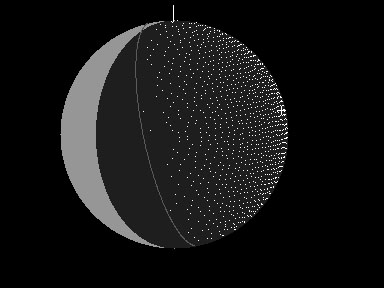2017 November 30
Upcoming Opportunity to Video Lunar Impact Flashes from the Geminid Meteor Shower
On Dec 12-15 there is the opportunity for astronomers in the UK, and elsewhere, to capture video of the 35 km/s Geminid meteoroids striking the lunar surface on the eastern night side. That speed is the equivalent to doing the London to Brighton run in just 3 seconds. But unlike meteors in our atmosphere, which produce lovely shooting star trails when they burn up gradually, on the Moon they just strike a solid surface and it’s all over in a fraction of a second. However if you were standing on the lunar surface, several metres to tens of metres away from the crash site, four things would happen almost simultaneously: all of a sudden a small crater would appear, and depending upon where you stood you could be blinded temporarily by a flash of red light; you would most likely be hit by high velocity shrapnel travelling at 1-2 km/s, and finally you might experience a seismic shock. It is the extremely luminous flash of light, that can be detected in Earth-based amateur sized telescopes as 7-10th magnitude, or brighter, short 0.1 second red flashes.

Amateur astronomers have made great contributions in observing large impacts on Jupiter in recent years, but such impacts are rare to see in an amateur sized scope, perhaps only one per month or so. Lunar impact flashes, seen through Earth-based telescopes occur at a rate of about one per several hours, but are more frequent during major meteor showers. You just need to have a monochrome camera capable of videoing stars down to magnitude 9 or 10 in real time and the capability to capture and record uncompressed video to computer hard drive, or even to old fashioned analogue VHS or camcorder Digital-8 video tape.

The Moon will be well presented for impact flash studies on Dec 12-15, with earthshine on the eastern half of the disk and a small phase illumination of between 30% and 8%, though you will have to get up early in the morning to observe – see http://users.aber.ac.uk/atc/lunar_schedule.htm for a schedule.
We are organising an observing programme at the Department of Physics at Aberystwyth University, for anyone interested in attempting this. We intend to combine together as many video observations as possible in order to produce high accuracy photometric light curves of the impact, and possibly colour temperature measurements too. If you would like to take part in this exciting new programme, which is being run in conjunction with the BAA Lunar Section, please email me for a PDF file containing lots of useful impact flash observing tips. Regular updates on preparation, planning, and impact flash detections, will be tweeted on: http://twitter.com/lunarnaut .
Acknowledgments
Figure 2 is from the LunarScan program by Peter Gural, for 2017 Dec 14.
Software for the detection of impact flashes, in support of this programme, has been made possible by the Horizon 2020, Europlanet 2020 Research Infrastructure (EPN2020-RI, http://www.europlanet-2020-ri.eu ).
Contact Details:
Dr Tony Cook (Assistant Director of the BAA Lunar Section)
Department of Physics,
Aberystwyth University,
Aberystwyth.
SY23 3BZ.
Email: atc<at>aber.ac.uk
| The British Astronomical Association supports amateur astronomers around the UK and the rest of the world. Find out more about the BAA or join us. |
